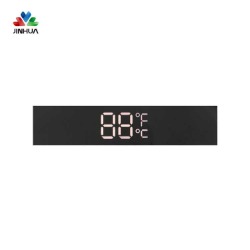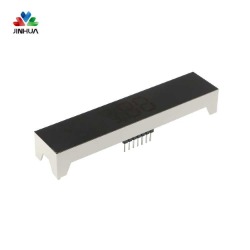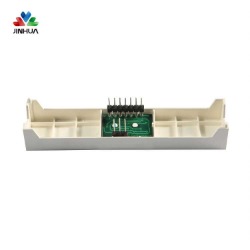Структура TFT-LCD. Жидкокристаллические дисплеи на тонкопленочных транзисторах состоят из трех основных компонентов: экрана дисплея, подсветки и схемы управления.
Экран дисплея TFT-LCD включает в себя стеклянную подложку, пленку цветного фильтра и жидкокристаллический материал. Процесс подготовки стеклянной подложки состоит из трех фотолитографических масок: сначала непрерывно наносят пленку ITO (толщина 20–50 нм) и пленку Cr (толщина 50–100 нм) на стеклянную подложку и фотолитографические шаблоны, а затем непрерывно наносят пленку изолирующего затвора SiN. : (толщина около 400 нм), а затем внутренний a-Si (толщина 50~100 нм) м) и слой n+a-Si и рисунок фотолитографии (сухой метод) для нанесения пленки Al, фотолитографии электрода сток-исток и, наконец, с использованием электрода сток-исток в качестве маски, самовыравнивающегося травления Cr пленка и TFT на пиксельном электроде, пленка n+a-Si между истоком и стоком. Это простой процесс изготовления TFT с обратной шахматной структурой. Следующим шагом является нанесение полиимидного выравнивающего слоя на стеклянную подложку и протирание его фланелью в определенном направлении для образования тонких каналов в том же направлении на поверхности выравнивающего слоя для контроля выравнивания молекул жидкого кристалла. При условии, что направления верхних и нижних ориентационных канавок двух стеклянных подложек ортогональны, две стеклянные подложки запечатываются в коробку. Зазор между ящиками обычно составляет всего несколько микрон (например, 10 мкм), а затем жидкокристаллический материал вакуумируется и заполняется.
Цветной фильтр (Color Filter) обозначается как CF. Цветной дисплей TFT-LCD фактически использует свет, проходящий через подложку матрицы, для освещения цветной пленки, а экран дисплея может отображать цвета. Цветную фильтрующую пленку (например, цветной целлофан) можно изготовить поверх прозрачного электрода (между прозрачным электродом и слоем жидкого кристалла) или под прозрачным электродом (между прозрачным электродом и стеклом), причем верхняя и нижняя стеклянные подложки и CF. Точность выравнивания пленки очень высока, что требует точного совмещения черно-белой матрицы CF-пленки с краем пиксельного электрода ITO. Пленка CF прикрепляется к поверхности жидкокристаллической ячейки, а затем жидкокристаллическая ячейка помещается между двумя бесцветными поляризаторами. Принцип цветного дисплея можно кратко описать следующим образом: разделите пиксель TFT-ЖК-дисплея на три основных цвета: красный, зеленый и синий (R, G, B), которые соответствуют RGB пленки CF. ЖК-дисплей, действующий как световой клапан, контролирует передачу света. Три цвета света пленки CF сбалансированы и отрегулированы для получения желаемого цвета. Если падающий свет, проходящий через пленку CF, просачивается, это влияет на контрастность TFT-ЖК-дисплея, поэтому в зазоре необходимо установить светозащитную черную матрицу (Black Matrix), называемую BM. Для стабильности и гладкости акриловая смола и эпоксидная смола используются для создания защитного слоя (oe cota) толщиной от 0,5 до 2 мкм, называемого OC. Затем на этом защитном слое формируется общий электрод — прозрачная электродная пленка. Слой БМ обычно изготавливается из металлического хрома (Cr). Чтобы уменьшить отражение поверхности, также используется оксид хрома (CrOx) или смола. Толщина металлического хрома составляет от 1000 до 1500 ангстрем, и он окрашен смолой, красителем или пигментом в виде цветного слоя. Цветовая гамма каждого пикселя различается в зависимости от назначения TFT-ЖК-дисплея. Например, ее можно расположить полосами, мозаикой, треугольниками и т. д. Характеристики пленки CF выражаются в пропускаемости, чистоте цвета, контрастности и низком отражении, поэтому требования к пленке CF таковы: высокий коэффициент пропускания и чистота цвета; высокая контрастность и плоскостность, а также чрезвычайно низкое диффузное отражение.
Жидкокристаллический материал. По неполным статистическим данным, существует более 10 000 видов полимерных соединений, которые можно использовать в качестве жидкокристаллических материалов. Обычно трудно использовать жидкокристаллический материал, отвечающий основным техническим показателям, таким как температурный диапазон, коэффициент упругости, диэлектрическая проницаемость, анизотропия показателя преломления и вязкость, требуемым устройством. В технике смешанные жидкие кристаллы необходимо использовать для модуляции физических свойств. Обычно используемые репрезентативные жидкокристаллические материалы можно разделить на три основные категории в соответствии с различными направлениями молекулярного расположения: одна из них — нематический жидкий кристалл. В этом жидкокристаллическом материале длинные оси молекул параллельны, и молекулы могут не только вращаться и скользить, но и двигаться вверх и вниз; второй — холестерический жидкий кристалл. В этом жидкокристаллическом материале молекулы ориентированы в разных плоскостях. В одной и той же плоскости длинная ось молекул параллельна директору каждой плоскости и закручивается слой за слоем, демонстрируя спиральное изменение; третий — околофазовый жидкий кристалл.
Этот вид жидкокристаллического материала имеет молекулы, расположенные в слоистой форме. Длинные оси молекул в каждом слое параллельны и могут двигаться параллельно друг другу, но молекулы не могут свободно скользить между слоями. Основными характеристиками жидкокристаллических материалов являются: они имеют тонкую молекулярную структуру, а их электропроводность слоя, диэлектрическая проницаемость и показатель преломления различны в двух направлениях, перпендикулярных и параллельных молекулярному директору, и изменяются в зависимости от внешних условий, таких как температура и частота движения. изменять. Кроме того, анизотропия показателя преломления велика, и жидкокристаллическую ячейку можно сделать тоньше, обеспечивая при этом тот же оптический эффект. Напряженность электрического поля при том же напряжении может увеличить скорость отклика жидкокристаллической ячейки.
TFT-LCD подсветка. Сам жидкий кристалл не излучает свет, и необходимо применять внешнюю подсветку. Такое внешнее освещение называется подсветкой. Подсветку ЖК-дисплея можно условно разделить на три типа: краевую, прямую и самосветящуюся в зависимости от взаимного расположения поверхности жидкокристаллического дисплея и источника света. Лампы накаливания и белые галогенные лампы являются точечными источниками света, люминесцентные лампы (с горячими катодами, холодными катодами) — линейными, а электролюминесцентные (ЭЛ) и матричные светодиоды — поверхностными источниками света. Краевая подсветка — это люминесцентные лампы, которые объединяют линейные источники света по бокам площади дисплея. Чтобы обеспечить равномерную яркость в области дисплея, в боковой подсветке используются меры по сбору света и светопроводности. Сбор света должен эффективно заставлять падающий свет излучаться с одной стороны, а световод должен отражать свет, излучаемый из сборника, чтобы сделать его плоским источником света; прямая подсветка расположена непосредственно под областью дисплея, оснащена 1 или несколькими расположенными рядом лампами с холодным катодом, оснащенными пластинами диффузного рассеивания поверх ламп с холодным катодом для устранения пятен, вызванных лампами с холодным катодом; самосветящаяся подсветка оснащена электролюминесцентной пластиной под областью дисплея. Электролюминесценция — это поверхностная люминесценция, которая может излучать свет равномерно по всей поверхности без пятен. Цвета люминесценции — зеленый, синий и белый, яркость — от 30 до 100 нит. Тенденция развития подсветки TFT-LCD: большой экран, высокая яркость, широкий угол обзора, тонкость, легкий вес, низкое энергопотребление и низкая цена. .
Схема привода TFT-LCD. Для отображения произвольной графики TFT-LCD использует матричный дисплей с прогрессивной разверткой и расположением точек m×n. При проектировании схемы управления мы должны сначала учитывать, что электролиз жидких кристаллов приведет к ухудшению качества жидкокристаллического материала. Для обеспечения долговечности обычно используется привод переменного тока. Сформированные режимы управления включают в себя: режим выбора напряжения, режим линейного изменения, режим ЦАП, аналоговый режим и т. д. Поскольку TFT-ЖК-дисплей в основном используется в ноутбуках, схема управления грубо разделена на: цепь управления сигналом, цепь питания, Схема напряжения шкалы серого, схема управления общим электродом, схема управления линией передачи данных и схема управления линией адресации (ИС управления затвором).
Основными функциями вышеупомянутой схемы управления являются: схема управления сигналами подает цифровые сигналы, сигналы управления и тактовые сигналы на цифровую ИС и подает сигналы управления и тактовые сигналы на ИС управления затвором; схема питания подает необходимое напряжение питания на цифровую ИС и ИС управления затвором; схема серого напряжения подает 10 серых напряжений, генерируемых цифровой схемой управления, на драйвер данных соответственно; общий. Схема управления электродами подает общее напряжение на общий электрод относительно пиксельного электрода; Схема управления линией данных фиксирует каждые 6-битные данные отображения и тактовый сигнал сигнала RGB, отправленного из схемы управления сигналом, в временной последовательности, и продолжает их внутри, а затем эти данные отображения преобразуются в аналоговый сигнал с помощью 6-битного DA-преобразователь, а затем преобразуется в импеданс по выходной цепи и подается на линию данных ЖК-экрана; Схема управления затвором переключает тактовый сигнал из схемы управления сигналом на напряжение ВКЛ/ВЫКЛ выходной схемы посредством преобразования сдвигового регистра, а затем последовательно подает его на ЖК-экран. Наконец, схема привода собирается на TAB (гибкая плата для автоматической сварки) и подключается к ЖК-дисплею с помощью ACF (анизотропная проводящая клейкая пленка) и TCP (гибкая лента для схемы привода).
Принцип работы TFT-LCD. Во-первых, представлен принцип отображения. Принцип жидкокристаллического дисплея основан на том факте, что светопропускание жидкого кристалла изменяется в зависимости от величины приложенного к нему напряжения. Когда свет проходит через верхний поляризатор, он становится линейно поляризованным. Направление поляризации соответствует направлению вибрации поляризатора и соответствует порядку расположения молекул жидкого кристалла на верхней и нижней стеклянной подложке. Когда свет проходит через слой жидкого кристалла, линейно поляризованный свет разлагается на два луча света из-за преломления жидким кристаллом. А поскольку два луча света распространяются с разной скоростью (с одной и той же фазой), когда два луча света объединяются, направление вибрации вибрирующего света неизбежно изменится. Свет, проходящий через слой жидкого кристалла, постепенно искажается. Когда свет достигает нижнего поляризатора, направление вибрации его оптической оси скручивается на 90 градусов и остается в соответствии с направлением вибрации нижнего поляризатора. Таким образом, свет проходит через нижний поляризатор, образуя яркое поле. После подачи напряжения жидкий кристалл ориентируется под действием электрического поля и искажения исчезают. В это время линейно поляризованный свет, проходящий через верхний поляризатор, больше не вращается в слое жидкого кристалла и не может пройти через нижний поляризатор, образуя темное поле. Видно, что сам жидкий кристалл не излучает свет и может отображаться при модуляции внешнего источника света. В течение всего процесса отображения жидкий кристалл действует как световой клапан, управляемый напряжением. Принцип работы TFT-LCD можно кратко описать так: когда прямое напряжение затвора превышает приложенное напряжение, электрод сток-исток включается, а когда прямое напряжение затвора равно 0 или отрицательному напряжению, сток -исходный электрод выключен. Электрод стока подключен к электроду пикселя ITO, электрод истока подключен к линии истока (электрод столбца), а электрод затвора подключен к линии затвора (электрод строки). Это простой принцип работы TFT-LCD.
Ключевые технологии TFT-LCD. Существует множество ключевых технологий для TFT-ЖК-дисплей, в основном включая следующие основные аспекты:
Во-первых, это усовершенствование технологии скорости открытия. Светосила относится к соотношению светопропускающей части и непрозрачной части TFT-ЖК-дисплея. Чем больше светосила, тем выше яркость. Основными факторами, которые влияют на светосилу, являются ширина шины затвора и истока, размер TFT, точность выравнивания верхней и нижней коробки подложки, размер накопительного конденсатора и размер черной матрицы и т. д. Чтобы улучшить светосилу, принят метод, заключающийся в том, чтобы сделать как черно-белая матрица, так и цветной фильтр на подложке TFT. Этот метод позволяет избежать уменьшения светосилы, вызванного точностью центровки коробки, но выход продукции не очень высок и соответственно возрастет стоимость. Другой — это шина «затвор-исток», в которой используется технология микрообработки интегральных схем. В 1990-х годах матрица TFT была подвергнута микрообработке до размера около 10 мкм и светосилы 35%. Когда микрообработка достигла 5 мкм, апертура составила 80%. Третий – использовать технологию самовыравнивающейся литографии.
Основная цель — устранить паразитную емкость, образующуюся в результате перекрытия затвора, истока и стока. Используя технологию самовыравнивающейся фотолитографии, электрод затвора используется в качестве маски для фототравления n+a-Si, а также электродов истока и стока, чтобы уменьшить перекрытие между электродами затвора и истока. Последний шаг — улучшение материалов ворот и источников. Чтобы увеличить светосилу, ширину шины следует сохранять как можно меньшей, но следует учитывать проблему снижения контрастности из-за чрезмерного сопротивления шины, задержки входного сигнала и недостаточной возбуждения. Обычно металл Cr или MoTa плакируют Al, чтобы можно было получить шину с низким сопротивлением.
Второе – это технологии, расширяющие перспективы. Анизотропия молекул жидких кристаллов определяет различное пространственное распределение молекул жидких кристаллов и различную прозрачность света под разными телесными углами. Это важная причина неравномерной контрастности дисплея. Поэтому расширение угла обзора является одним из ключевых вопросов в технологии жидкокристаллических дисплеев. К общепринятым техническим мерам относятся: компенсационная мембранная технология. На ЖК-экранСветорассеивающая пленка и пленка для компенсации интенсивности света прикреплены для равномерного рассеивания света, проходящего через ЖК-экран, и компенсации интенсивности света под определенными углами. Кроме того, многодоменная технология используется для разделения более двух различных областей расположения молекул жидкого кристалла внутри пикселя для формирования ориентации многодоменных молекул жидкого кристалла, тем самым достигая цели расширения угла обзора. Технологии расширения угла обзора также включают такие методы и меры, как IPS и ASM.
В-третьих, упрощение процесса изготовления TFT-матрицы. Обычно количество травлений для процесса матрицы TFT составляет от 7 до 9 раз. Технологический процесс слишком длинный, что влияет на скорость квалификации продукта и производственную мощность. В зарубежной литературе сообщается, что существовало четыре процесса наложения, что вдвое меньше обычных процессов TFT-матрицы.
Конечно, ключевые технологии жидкокристаллических дисплеев — это не только три вышеупомянутых аспекта, но и наиболее важные технологии, влияющие на качество TFT-LCD. Другие ключевые технологии здесь обсуждаться не будут.








 English
English Deutsch
Deutsch русский
русский español
español العربية
العربية



 IPv6 ПОДДЕРЖИВАЕТСЯ СЕТЬЮ
IPv6 ПОДДЕРЖИВАЕТСЯ СЕТЬЮ
